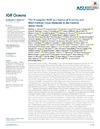Identificador persistente para citar o vincular este elemento:
https://accedacris.ulpgc.es/jspui/handle/10553/73656
| Título: | The Transpolar Drift as a Source of Riverine and Shelf-Derived Trace Elements to the Central Arctic Ocean | Autores/as: | Charette, Matthew A. Kipp, Lauren E. Jensen, Laramie T. Dabrowski, Jessica S. Whitmore, Laura M. Fitzsimmons, Jessica N. Williford, Tatiana Ulfsbo, Adam Jones, Elizabeth Bundy, Randelle M. Vivancos, Sebastian M. Pahnke, Katharina John, Seth G. Xiang, Yang Hatta, Mariko Petrova, Mariia V. Heimbürger-Boavida, Lars Eric Bauch, Dorothea Newton, Robert Pasqualini, Angelica Agather, Alison M. Amon, Rainer M.W. Anderson, Robert F. Andersson, Per S. Benner, Ronald Bowman, Katlin L. Edwards, R. Lawrence Gdaniec, Sandra Gerringa, Loes J.A. González, Aridane G. Granskog, Mats Haley, Brian Hammerschmidt, Chad R. Hansell, Dennis A. Henderson, Paul B. Kadko, David C. Kaiser, Karl Laan, Patrick Lam, Phoebe J. Lamborg, Carl H. Levier, Martin Li, Xianglei Margolin, Andrew R. Measures, Chris Middag, Rob Millero, Frank J. Moore, Willard S. Paffrath, Ronja Planquette, Hélène Rabe, Benjamin Reader, Heather Rember, Robert Rijkenberg, Micha J.A. Roy-Barman, Matthieu Rutgers van der Loeff, Michiel Saito, Mak Schauer, Ursula Schlosser, Peter Sherrell, Robert M. Shiller, Alan M. Slagter, Hans Sonke, Jeroen E. Stedmon, Colin Woosley, Ryan J. Valk, Ole van Ooijen, Jan Zhang, Ruifeng |
Clasificación UNESCO: | 2510 Oceanografía | Palabras clave: | Arctic Ocean Carbon Geotraces Nutrients Trace Elements, et al. |
Fecha de publicación: | 2020 | Publicación seriada: | Journal of geophysical research. Oceans | Resumen: | A major surface circulation feature of the Arctic Ocean is the Transpolar Drift (TPD), a current that transports river-influenced shelf water from the Laptev and East Siberian Seas toward the center of the basin and Fram Strait. In 2015, the international GEOTRACES program included a high-resolution pan-Arctic survey of carbon, nutrients, and a suite of trace elements and isotopes (TEIs). The cruises bisected the TPD at two locations in the central basin, which were defined by maxima in meteoric water and dissolved organic carbon concentrations that spanned 600 km horizontally and ~25–50 m vertically. Dissolved TEIs such as Fe, Co, Ni, Cu, Hg, Nd, and Th, which are generally particle-reactive but can be complexed by organic matter, were observed at concentrations much higher than expected for the open ocean setting. Other trace element concentrations such as Al, V, Ga, and Pb were lower than expected due to scavenging over the productive East Siberian and Laptev shelf seas. Using a combination of radionuclide tracers and ice drift modeling, the transport rate for the core of the TPD was estimated at 0.9 ± 0.4 Sv (106 m3 s−1). This rate was used to derive the mass flux for TEIs that were enriched in the TPD, revealing the importance of lateral transport in supplying materials beneath the ice to the central Arctic Ocean and potentially to the North Atlantic Ocean via Fram Strait. Continued intensification of the Arctic hydrologic cycle and permafrost degradation will likely lead to an increase in the flux of TEIs into the Arctic Ocean. | URI: | https://accedacris.ulpgc.es/handle/10553/73656 | ISSN: | 2169-9275 | DOI: | 10.1029/2019JC015920 | Fuente: | Journal of Geophysical Research: Oceans [ISSN 2169-9275], v. 125 (5), e2019JC015920 (Mayo 2020) |
| Colección: | Artículos |
Citas SCOPUSTM
121
actualizado el 08-jun-2025
Citas de WEB OF SCIENCETM
Citations
115
actualizado el 08-jun-2025
Visitas
142
actualizado el 31-may-2025
Descargas
261
actualizado el 31-may-2025
Google ScholarTM
Verifica
Altmetric
Comparte
Exporta metadatos
Los elementos en ULPGC accedaCRIS están protegidos por derechos de autor con todos los derechos reservados, a menos que se indique lo contrario.
